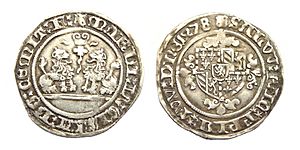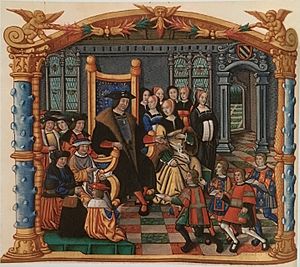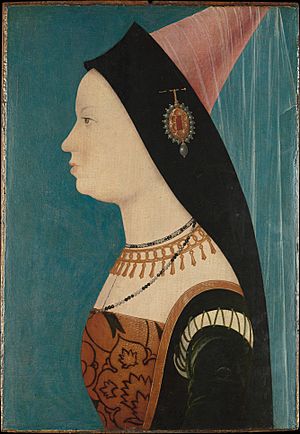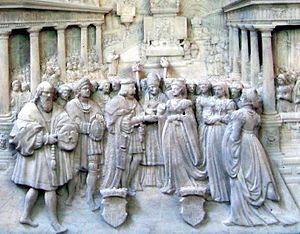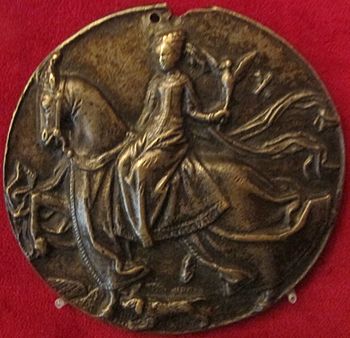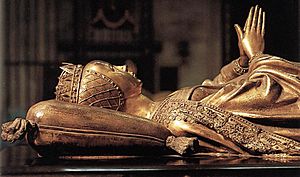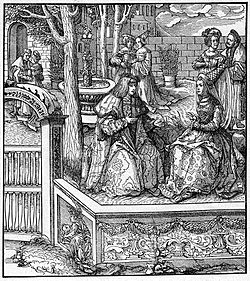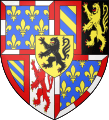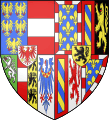Mary of Burgundy facts for kids
Quick facts for kids Mary of Burgundy |
|
|---|---|
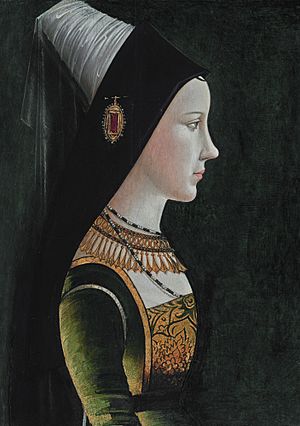
Mary of Burgundy wearing a hennin, portrait possibly painted by Michael Pacher, c. 1490.
|
|
| Duchess of Burgundy | |
| Reign | 5 January 1477 – 27 March 1482 |
| Predecessor | Charles I |
| Successor | Philip IV |
| Alongside | Maximilian |
| Born | 13 February 1457 Brussels, Brabant, Burgundian Netherlands |
| Died | 27 March 1482 (aged 25) Wijnendale Castle, Flanders, Burgundian Netherlands |
| Burial | Bruges, Flanders |
| Spouse | |
| Issue | Philip I of Castile Margaret, Duchess of Savoy |
| House | Valois-Burgundy |
| Father | Charles the Bold |
| Mother | Isabella of Bourbon |
| Religion | Roman Catholicism |
Mary of Burgundy (French: Marie de Bourgogne; Dutch: Maria van Bourgondië; 13 February 1457 – 27 March 1482), nicknamed the Rich, titular Duchess of Burgundy, reigned over the Burgundian State, now mainly in France—with the exception of the Duchy of Burgundy returned to the Kingdom of France (1477)—and the Low Countries, from 1477 until her death in a riding accident at the age of 25.
As the only child of Charles the Bold, Duke of Burgundy, and his wife Isabella of Bourbon, she inherited the Burgundian lands at the age of 19 upon the death of her father in the Battle of Nancy on 5 January 1477. In order to counter the appetite of the French king Louis XI for her lands, she married Maximilian of Habsburg, who became Holy Roman Emperor Maximilian I long after her death. The marriage kept large parts of the Burgundian lands from disintegration, but also a change of dynasty from the Valois to the Habsburg (the Duchy of Burgundy itself became a French possession). This was a turning point in European politics, leading to a French–Habsburg rivalry that would endure for centuries.
Contents
Early years
Mary of Burgundy was born in Brussels at the ducal castle of Coudenberg, to Charles the Bold, then known as the Count of Charolais, and his wife Isabella of Bourbon. Her birth, according to the court chronicler Georges Chastellain, was attended by a clap of thunder ringing from the otherwise clear twilight sky. Her godfather was Louis, Dauphin of France, in exile in Burgundy at that time; he named her for his mother Marie of Anjou. Reactions to the child's birth were mixed: the baby's grandfather, Duke Philip the Good, was unimpressed, and "chose not to attend the [baptism] as it was only for a girl", whereas her grandmother Isabella of Portugal was delighted at the birth of a granddaughter. Her illegitimate aunt Anne was assigned to be responsible for Mary's education and assigned Jeanne de Clito to be her governess. Jeanne remained a constant friend to Mary later in life and was one of her most constant companions.
Heir presumptive
Philip the Good died in 1467 and Mary's father assumed control of the Burgundian State. Since her father had no living sons at the time of his accession, Mary became his heir presumptive. Her father controlled a vast and wealthy domain made up of the Duchy of Burgundy, the Free County of Burgundy, and the majority of the Low Countries. As a result, her hand in marriage was eagerly sought by a number of princes. The first proposal was received by her father when she was only five years old, in this case to marry the future King Ferdinand II of Aragon. Later she was approached by Charles, Duke of Berry; his older brother, King Louis XI of France, was intensely annoyed by Charles's move and attempted to prevent the necessary papal dispensation for consanguinity.
As soon as Louis succeeded in producing a male heir who survived infancy, the future King Charles VIII of France, Louis wanted him to be the one to marry Mary, even though he was thirteen years younger than Mary. Nicholas I, Duke of Lorraine, was a few years older than Mary and controlled a duchy that lay alongside Burgundian territory, but his plan to combine his domain with hers was ended by his death in battle in 1473.
Reign
Mary assumed the rule of her father's domains upon his defeat in battle and death on 5 January 1477. King Louis XI of France seized the opportunity to attempt to take possession of the Duchy of Burgundy proper and also the regions of Franche-Comté, Picardy and Artois.
The king was anxious that Mary should marry his son Charles and thus secure the inheritance of the Low Countries for his heirs, by force of arms if necessary. Burgundy, fearing French military power, sent an embassy to France to negotiate a marriage between Mary and the six-year-old Dauphin (later King Charles VIII), but returned home without a betrothal; the French king's demands of cession of territories to the French crown were deemed unacceptable.
The Great Privilege
Mary was compelled to sign a charter of rights known as the Great Privilege in Ghent on 10 February 1477 on the occasion of her formal recognition as her father's heir (the "Joyous Entry"). Under this agreement, the provinces and towns of Flanders, Brabant, Hainaut, and Holland recovered all the local and communal rights that had been abolished by the decrees of the dukes of Burgundy in their efforts to create a centralised state on the French model out of their disparate holdings in the Low Countries. In particular, the Parliament of Mechelen (established formally by Charles the Bold in 1470) was abolished and replaced with the pre-existing authority of the Parliament of Paris, which was considered an amenable counterweight to the encroaching centralisation undertaken by both Charles the Bold and Philip the Good. The duchess also had to undertake not to declare war, make peace, or raise taxes without the consent of these provinces and towns and only to employ native residents in official posts.
Such was the hatred of the people for the old regime that in spite of the duchess's entreaties, two of her father's most influential councilors, the Chancellor Hugonet and the Sire d'Humbercourt, were executed in Ghent after it was discovered that they were in correspondence with the king of France.
Marriage
Mary soon made her choice among the many suitors for her hand by selecting Archduke Maximilian of Austria, the future Holy Roman Emperor Maximilian I, who became her co-ruler. The marriage took place at Ghent on 19 August 1477, she was 20 years old, while he was two years younger. Mary's marriage into the House of Habsburg initiated two centuries of contention between France and the Habsburgs, a struggle that climaxed with the War of the Spanish Succession in the years 1701–1714.
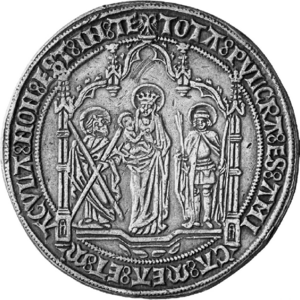
When they had time, the couple indulged themselves with dancing, hunting, music and the love for animals. Mary tried to teach him iceskating, that he struggled to master. They read romances together. Soon after the wedding, she brought falcons into their bedroom (which they shared instead of living in separate apartments, and which already had a dog). Mary nursed the children herself, ordered the menus and dined out with merchants from Dijon. Mary cheered for her husband in tournaments, during which he proved a magnificent jouster, not just in feats of strength but in the luxury he lavished on the equipments, horses, accessories and ornaments as well. At first, they talked to each other in Latin.
According to Haemers and Sutch, the original marriage contract stipulated that Maximilian could not inherit her Burgundian lands if they had children – this means that, the fact the couple produced heirs would give Maximilian troubles later. Some report that the original marriage contract stipulated that only common children of Mary and Maximilian could claim her Burgundian inheritance after her death. But one month after their marriage, she made an amendment that designated Maximilian as the heir in the case they had no children - a clause that the estates would try to repudiate after her death.
Co-rule with Maximilian
With Maximilian by her side, Mary's position became stronger, politically and militarily. Although he came with no money nor army, nor support from the Empire, and no prior experience in governance, his competence in military matters and his prestige as the son of an emperor boosted the stability of her realms. He took over the war effort, concerning both military and financial details. By this time, the Burgundian side had lost a lot of military captains due to defections to France both before and after Charles the Bold's death. Philip of Cleves, her cousin and childhood friend (who had been put forth as a bridegroom candidate for Mary by his father Adolf of Cleves; Mary and Philip were rumoured to be former love interests, although this is disputed by Arie de Fouw), whom she appointed as Stadtholder-General in 1477, now acted as Maximilian's lieutenant as Admiral of the Netherlands. She would not gain back the Duchy of Burgundy, but she was able to keep her remaining lands intact. Despite the reputation of the Burgundian court as luxurious and rich, Charles the Bold had lost his whole fortune in his last three disastrous campaigns. The Low Countries were rich but the Estates were reluctant to pay. Thus the initial financial situation was very tense and Mary had to pawn a lot of her heirlooms to finance their armies. She also had to yield to the estates' demands regarding some of their privileges, in exchange for final support for Maximiland's war against France. In 1478–1479, he carried out a campaign against the French and reconquered Le Quesnoy, Conde and Antoing. He defeated the French forces at Guinegatte, the modern Enguinegatte, on 7 August 1479 Despite winning, Maximilian had to abandon the siege of Thérouanne and disband his army, either because the Netherlanders did not want him to become too strong or because his treasury was empty. In addition, he proved as ruthless as Charles in suppressing rebellions in the Low Countries. When conflicts broke out again between the Hooks and the Cods, the archduke was able to put the conflict under control and assured the Cod domination, disregarding the Great Privilege in the process. After a five-year hiatus, the Order of the Golden Fleece also got reorganized by Maximilian, as the new sovereign of the order.
She retained her political primacy among the couple though. Her subjects looked at Maximilian's foreigner status and his military ambitions suspiciously. They feared that he would prolong the war to regain the Duchy of Burgundy, and also that new successes would strengthen him and make him a second coming of Charles the Bold, whose legacy had left them with a feeling of distaste – a fear that would prove not unreasonable, considering his autocratic and militaristic tendencies during his later regency. Moreover, according to Philippe de Commines, Maximilian was too young, in a foreign land, had been "brought up very badly" and thus did not have the slightest idea how to conduct affairs of the state. Mary and Margaret tried to teach him French and Dutch but he proved a lazy student. Mary accompanied Maximilian on his many journeys, acting as the buffer between the German-speaking prince and their subjects. According to Juan Luis Vives, a near contemporary author, when her subjects approached her on political matters, she would consult her husband "whose will she regarded as law", but she was always able to administer everything according to her own wishes and Maximilian, a mild husband, would never oppose her will. She managed internal affairs and attended all assemblies where the couple needed to raise revenue. Burgundian coinage showed that Maximilian was never endowed with the official rank that contemporary royal husbands such as Ferdinand of Aragon achieved in their wives' possessions. Apparently, she could impose her will on her spouse in military matters as well, as shown in the two times she tried to do this. In one case, recounted by Maximilian in the manuscript of the Weisskunig, his advisors tried to prevent him from unleashing war against a stronger French army who had concentrated at the front, but he was determined to carry it out. The advisors asked for help from Mary, who told him he could go but should come back to say farewell to her first. When he went back, she had him promptly locked up in his own apartment. After long negotiations, he agreed to go dancing instead and was let out. In her official images and presentation, she was presented as an active, commanding ruler, usually on horseback and with a hawk. She adopted a more pacifistic image than her father, but her position as the rightful ruler was emphasized while Maximilian, armored and armed, tended to be shown behind his wife. This was in contrast with the profile portraits that Maximilian commissioned during his later reign as emperor, where she was often shown as the passive side.
In order to bolster support for the government, she focused the most on public appearances, especially public shows of piety.
The 1482 winter was harsh and France had declared a salt blockade, but the political situation in the Netherlands was overall positive; the French aggression was temporarily checked, and internal peace was in large measure restored.
Death and legacy

In 1482, a falcon hunt in the woods near Wijnendale Castle was organised by Adolph of Cleves, Lord of Ravenstein, who lived in the castle. Mary loved riding and was hunting with Maximilian and knights of the court when her horse tripped, threw her in a ditch, and then landed on top of her, breaking her back. She died several weeks later on 27 March from internal injuries, having made a detailed will. She was buried in the Church of Our Lady in Bruges on 3 April 1482. She was pregnant.
Maximilian was devastated. She had initially hidden the extent of her injury to calm him down. When he continued to display uncontrollable grief, she had to force him out of her chamber so that she could discuss matters of the state with her nobles, concerning which she asked them to keep their loyalty oath to him and their children. Maximilian was not present when she said her last words.
The bankrupted court honoured her with a glorious funeral, as Maximilian melted down the crockery for the occasion.
Her two-year-old daughter, Margaret of Austria, was sent in vain to France, to marry the Dauphin, in an attempt to please Louis XI and persuade him not to invade the territories owned by Mary.
Louis was swift to re-engage hostilities with Maximilian and forced him to agree to the Treaty of Arras of 1482, by which Franche-Comté and Artois passed for a time to French rule, only to be recovered by the Treaty of Senlis of 1493, which established peace in the Low Countries. Mary's marriage into the House of Habsburg proved to be a disaster for France because the Burgundian inheritance later brought it into conflict with Spain and the Holy Roman Empire.
In 1493, Emperor Frederick III died. Maximilian became the de facto leader of the Empire and relinquished control of the Netherlands to his and Mary's son Philip. By this time, rebellions against Maximilian's authority had been subdued by force and a strong ducal monarchy was established. He made sure that during their son's inauguration, Philip confirmed only the rights granted to territories by the time of Philip the Good.
Olga Karaskova summarizes scholarly opinions on Mary's rule as follows:
Mary of Burgundy as ruler seems to be rather a non sequitur topic for a study as her short reign — sandwiched between those more important of her belligerent father, Charles the Bold, and her imposing spouse, Maximilian of Austria — is often marginalized by researchers. A somewhat ambiguous figure, whose image hovers somewhere in the space limited by two opposing concepts — an inexperienced and weak duchess, a mere pawn in the great political game played between France and the Holy Roman Empire, and a self-determined young princess who knew what she wanted and managed to dictate her will, praised by her biographers, Mary still remains generally in the shade of her nearest kinsmen despite the abundant publications concerning the Duchy of Burgundy.
In 2019, she was added to the Canon of Netherlands. The committee headed by James Kennedy explained that, "her Habsburg marriage determined the international position of the Netherlands for centuries." and that "her personality and the leniency of her government" preserved "the unity of the core regions of the Burgundian Netherlands.", even if most of the functions of the head of state were carried out by the energetic husband. Historian Jelle Haemers opines that she should not be made into a feminist icon.
Maximilian tended to describe Mary as the Grand Dame, who could stand next to him as sovereigns. The devotion the people of the Low Countries had towards Mary (often idealized as earthly representation of the Virgin Mary) helped Maximilian, their children and the central government in the turbulent period following her death.
Family
Mary's son Philip succeeded to her dominions under the guardianship of his father.
Her children were as follows:
- Philip the Handsome (22 July 1478 – 25 September 1506), who succeeded his mother as Philip IV of Burgundy and became Philip I of Castile through his marriage to Joanna of Castile (known to history as "Juana la Loca").
- Margaret (10 January 1480 – 1 December 1530), married firstly to Juan, Prince of Asturias, the son and heir of King Ferdinand II of Aragon and Queen Isabella I of Castile, and secondly to Philibert II, Duke of Savoy.
- Franz or François (2 September 1481 – 26 December 1481).
Ancestry
| Ancestors of Mary of Burgundy | ||||||||||||||||||||||||||||||||||||||||||||||||||||||||||||||||||||||||||||||||||||||||||||||||||||||||||||||||||||||||||||||||||||||||||||||||||||||||||||||||||||||||||||||||||||||||||||||||||||||||||||||||||||||||||||||||||||||||||||||||||||||||||||||||||||||||||||||||||||||||||||||||||||||||||||||||||||||||||||||||||||||||||||||||||||||||||||||||||||||||||||||||||||||||||||||||||||||||||||||||||||||||||||||||||||||||||||||||||||||||||||||||||||||||||||||||||||||||||||||||||||||||||||||||||||||||||||||||||||||||||||||||||||||||||||||||||||||||||||||||||||||||||||||||||||||||||||||||
|---|---|---|---|---|---|---|---|---|---|---|---|---|---|---|---|---|---|---|---|---|---|---|---|---|---|---|---|---|---|---|---|---|---|---|---|---|---|---|---|---|---|---|---|---|---|---|---|---|---|---|---|---|---|---|---|---|---|---|---|---|---|---|---|---|---|---|---|---|---|---|---|---|---|---|---|---|---|---|---|---|---|---|---|---|---|---|---|---|---|---|---|---|---|---|---|---|---|---|---|---|---|---|---|---|---|---|---|---|---|---|---|---|---|---|---|---|---|---|---|---|---|---|---|---|---|---|---|---|---|---|---|---|---|---|---|---|---|---|---|---|---|---|---|---|---|---|---|---|---|---|---|---|---|---|---|---|---|---|---|---|---|---|---|---|---|---|---|---|---|---|---|---|---|---|---|---|---|---|---|---|---|---|---|---|---|---|---|---|---|---|---|---|---|---|---|---|---|---|---|---|---|---|---|---|---|---|---|---|---|---|---|---|---|---|---|---|---|---|---|---|---|---|---|---|---|---|---|---|---|---|---|---|---|---|---|---|---|---|---|---|---|---|---|---|---|---|---|---|---|---|---|---|---|---|---|---|---|---|---|---|---|---|---|---|---|---|---|---|---|---|---|---|---|---|---|---|---|---|---|---|---|---|---|---|---|---|---|---|---|---|---|---|---|---|---|---|---|---|---|---|---|---|---|---|---|---|---|---|---|---|---|---|---|---|---|---|---|---|---|---|---|---|---|---|---|---|---|---|---|---|---|---|---|---|---|---|---|---|---|---|---|---|---|---|---|---|---|---|---|---|---|---|---|---|---|---|---|---|---|---|---|---|---|---|---|---|---|---|---|---|---|---|---|---|---|---|---|---|---|---|---|---|---|---|---|---|---|---|---|---|---|---|---|---|---|---|---|---|---|---|---|---|---|---|---|---|---|---|---|---|---|---|---|---|---|---|---|---|---|---|---|---|---|---|---|---|---|---|---|---|---|---|---|---|---|---|---|---|---|---|---|---|---|---|---|---|---|---|---|---|---|---|---|---|---|---|---|---|---|---|---|---|---|---|---|---|---|---|---|---|---|---|---|---|---|---|---|---|---|---|---|---|---|---|---|---|---|---|---|---|---|---|---|---|---|---|---|---|---|---|---|---|---|---|---|---|---|---|---|---|---|---|---|---|---|---|---|---|---|---|---|---|---|---|---|---|---|---|---|---|---|---|---|---|---|---|---|---|---|---|---|---|---|---|---|---|---|---|---|---|---|---|---|---|---|---|---|---|---|---|---|---|---|---|---|---|---|---|---|---|---|---|---|---|---|---|---|---|---|---|---|---|---|---|---|---|---|---|---|---|---|---|
|
||||||||||||||||||||||||||||||||||||||||||||||||||||||||||||||||||||||||||||||||||||||||||||||||||||||||||||||||||||||||||||||||||||||||||||||||||||||||||||||||||||||||||||||||||||||||||||||||||||||||||||||||||||||||||||||||||||||||||||||||||||||||||||||||||||||||||||||||||||||||||||||||||||||||||||||||||||||||||||||||||||||||||||||||||||||||||||||||||||||||||||||||||||||||||||||||||||||||||||||||||||||||||||||||||||||||||||||||||||||||||||||||||||||||||||||||||||||||||||||||||||||||||||||||||||||||||||||||||||||||||||||||||||||||||||||||||||||||||||||||||||||||||||||||||||||||||||||||
Titles
 5 January 1477 – 27 March 1482: Duchess of Burgundy (titular)
5 January 1477 – 27 March 1482: Duchess of Burgundy (titular) 5 January 1477 – 27 March 1482: Duchess of Lothier
5 January 1477 – 27 March 1482: Duchess of Lothier 5 January 1477 – 27 March 1482: Duchess of Brabant
5 January 1477 – 27 March 1482: Duchess of Brabant 5 January 1477 – 27 March 1482: Duchess of Limburg
5 January 1477 – 27 March 1482: Duchess of Limburg 5 January 1477 – 27 March 1482: Duchess of Luxemburg
5 January 1477 – 27 March 1482: Duchess of Luxemburg 5 January 1477 – 27 March 1482: Duchess of Guelders
5 January 1477 – 27 March 1482: Duchess of Guelders 5 January 1477 – 27 March 1482: Countess of Flanders
5 January 1477 – 27 March 1482: Countess of Flanders 5 January 1477 – 27 March 1482: Countess of Artois
5 January 1477 – 27 March 1482: Countess of Artois 5 January 1477 – 27 March 1482: Countess Palatine of Burgundy
5 January 1477 – 27 March 1482: Countess Palatine of Burgundy 5 January 1477 – 27 March 1482: Countess of Hainault
5 January 1477 – 27 March 1482: Countess of Hainault 5 January 1477 – 27 March 1482: Countess of Holland
5 January 1477 – 27 March 1482: Countess of Holland 5 January 1477 – 27 March 1482: Countess of Zeeland
5 January 1477 – 27 March 1482: Countess of Zeeland 5 January 1477 – 27 March 1482: Countess of Namur
5 January 1477 – 27 March 1482: Countess of Namur 5 January 1477 – 27 March 1482: Countess of Zutphen
5 January 1477 – 27 March 1482: Countess of Zutphen 5 January 1477 – 27 March 1482: Margravine of Antwerp
5 January 1477 – 27 March 1482: Margravine of Antwerp
See also
 In Spanish: María de Borgoña para niños
In Spanish: María de Borgoña para niños


